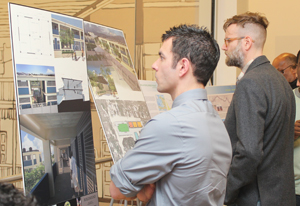by admin
Event: Building a Future with Haiti: A Grassroots Forum for Sustainable Development
Location: Center for Architecture, 03.18.11
Speakers: Amy Stroud, ASLA — Founder and President, Building Foundations with Haiti; Wendy Jules — volunteer, Community2Community; Winston Ely, LEED-AP — WE Design; Avi Guter, LEED-AP — Desimone Consulting Engineers; David Obuchowski, RA, LEED AP — DO Architecture; Charles Newman — Project Manager/Architect, Community2Community; Myles Throop — Project Manager/Civil Engineer, Community2Community; Erik Madsen — Structural Engineer (Association des Ingenieurs Haitiens et Americains); Marie-Yolaine Eusebe — Founder & Firestarter, Community2Community
Moderator: Rick Bell, FAIA — AIANY Executive Director
Organizers: Building Foundations; Community2Community; Planetary1
Sponsors: AIANY; NYASLA; Haiti Outreach Ministries; National Organization of Minority Architects; Clean The World; Mayer Brown, LLP; Ronnette Riley, FAIA, LEED-AP; Kohn Pedersen Fox Associates; Scopello’s Restaurant & Bar, Brooklyn; Brown Sugar’s Delights, Bronx; Weaver Associates Printing, Cranford, NJ
The challenges of relief work in Haiti after the January 2010 earthquake go beyond the formidable difficulties associated with “ordinary” seismic cataclysms. The nation’s problems range from a cholera epidemic to predatory dockworker practices (thanks to a few powerful families’ control of the ports, getting materials off the docks can cost three times their shipping expense) to a dysfunctional government, according to many informed observers. Along with rebuilding damaged facilities, Haitians and outside volunteers need to institute credible building codes and construct basic infrastructure for the first time. Haiti’s misfortunes are many, but its strengths include an exceptionally dedicated populace; this presentation of projects by two nonprofit groups, Building Foundations (a.k.a. Build.Found) and Community2Community (C2C), demonstrated how much energy, imagination, and expertise (both volunteer and local) Haiti inspires.
Build.Found is applying volunteer professional services to a new community complex in the Port-au-Prince suburb of Repatriote, home of refugees from the impoverished Cité Soleil district and deportees from the Dominican Republic. The Repatriote project grew out of an ASLA-NY design charrette and focuses on a Haiti Outreach Ministries church, built on an old landfill site and mostly torn down after a near-total collapse in the quake. Rebuilding it, enlarging it, and improving it structurally (adapting American codes), the volunteer architects have created a master plan that adds classrooms, a clinic, community-accessible soccer fields, and other facilities, using a grid of 20-foot-by-20-foot modules for sturdy, adaptable CMU-based construction. The complex employs sustainable design principles, including rainwater collection and natural ventilation relying on the area’s west-to-east prevailing winds. As Winston Ely, LEED-AP, from WE Design, explained, the team selected a shear-wall structure over a moment-frame design, since the former is less susceptible to material quality problems in an area where expertise with concrete is limited and crushed-limestone aggregate can be unreliable.
The Repatriote project expands on earlier achievements by Build.Found and its clients constructing a hospital in Cité Soleil. “People needed to come and see what has been done, and what is being done, and be empowered by that,” adds Build.Found President Amy Stroud, ASLA. “A lot of the really unfortunate parts of the disaster, and what’s come from the disaster, is that people are consistently seeing on the news things that haven’t been done, and this was a really good opportunity for them to see things that have been done, and that will be done very soon.” Build.Found’s next project, a vocational school and its supporting infrastructure, expands the opportunities for New York-based architects, landscape architects, and engineers to join forces with organizations whose roots in Haiti run deep.
In the mountainous village of Piton Vallue in Petit-Goâve, some 40 miles southwest of Port-au-Prince, C2C is working to provide potable water, repair and extend a road, and build a schoolhouse for children who currently have makeshift facilities at best. The C2C team is experimenting with assorted innovations, including a retaining wall of reclaimed auto tires and rammed earth, as well as more familiar strategies such as compost toilets. The pivotal task for Piton Vallue is to create a local water system with a solar-powered pump feeding an expandable series of water kiosks, which could become a local economic engine as well as a relief from long walks hauling water by hand. Residents have been enthusiastic enough to express interest in paying small water fees to support the kiosk network, one of many ways in which these projects include community residents as active participants.
As in so many aspects of post-earthquake relief in Haiti, the water is “not a fix to a catastrophic earthquake,” said C2C Engineer Myles Throop; “this is actually a more long-term development project — not only construction but also economic development and empowerment.” Water is the first step toward thorough development of schools, housing, and other community features that most Westerners take for granted. These signs of hope require synergies between newcomers’ and residents’ expertise, earning the confidence of wary Haitians. “How are you going to include them in that process? Because they don’t really want a part of it if they’re not included, because they don’t trust it, and they don’t trust it because of their history. So people have to understand the history behind it,” says Stroud. “We work hand in hand with the Haitian people on ground, with the Haitian engineers… working next to each other to figure out the best practices for that project.” Collaborating with Haitian contractors and vendors and drawing on their local knowledge, these projects are helping to rewrite Haitian-American relations from a story of isolation and exploitation to one of inclusive partnership.
Bill Millard is a freelance writer and editor whose work has appeared in OCULUS, Icon, Content, The Architect’s Newspaper, and other publications.


